
|
|
PRINT » |
|
|
E-MAIL THIS PAGE » |
|
|
CLOSE THIS WINDOW » |
Feature Article from the October 2008 Magazine Issue
Fighting Disease Organically
Active intervention required for mildew, Botrytis, Eutypa, etc.
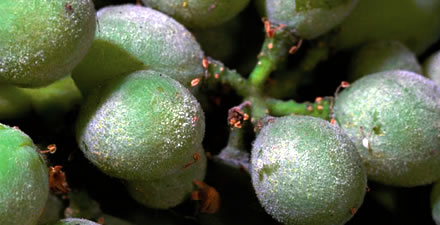
Copyright © University of California Regents
Organic growers have strategies and tools to deal with all of these diseases, and many are very effective. Unlike organic insect pest management, organic grapevine disease management almost always requires some kind of intervention and preventive strategies to keep diseases from doing serious damage to the crop. Using basic Integrated Pest Management (IPM) principles of knowing the disease lifecycles, using canopy management to reduce conditions that favor disease development, and monitoring for disease incidence and severity (below) are very helpful in timing sprays, dustings or other measures for maximum disease prevention and control.
All Vitis vinifera cultivars are susceptible to powdery mildew and will require treatments to prevent infection. Powdery mildew is present in nearly every vineyard in California. Old-time winegrowers say, "If you haven't found powdery mildew in your vineyard, you probably haven't looked close enough."
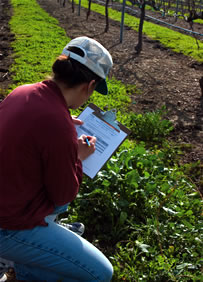
The critical damage occurs when fruit becomes infected, as the berries will not develop normally or ripen, appearing grayish-black stained and often cracking, resulting in unusable fruit at the winery. Losses can be severe if a protective fungicide program is not used. Control measures must be used while the fruit is susceptible, which ends when veraison (coloring and softening) occurs.
Organic winegrowers use fungicides based on naturally occurring materials, canopy management, predictive models for the disease based on temperature, and monitoring of the disease in the vineyard as components of their powdery mildew control program.
The causal agent of powdery mildew is Unicula necator. There are two stages to its life cycle. The first stage of the disease can overwinter either as cleistothecia or as bud perennation. Cleistothecia are fruiting bodies that produce ascospores. These structures form on infected leaves late in the growing season and wash down onto the trunks and spurs of the vine with winter rains. In the spring, the cleistothecia produce ascospores that will be released when the vineyard becomes wet, whether it is from heavy fog, rain or sprinklers. High humidity also will encourage the disease. Ascospore releases are favored by temperatures in the range of 68-75°F.
The infections from germinating ascospores occur as discolored chlorotic spots on the surface of basal leaves on the vine. Underneath the leaf corresponding to those spots, you will find the area covered with white fungal mycelium that will produce conidiaspores, which can spread the disease to the current season's growth.
Temperatures between 70° and 85°F favor the growth of the disease, especially when accompanied by high humidity (65% or greater). Under these conditions, the disease can infect and produce new spores every five days. Left untreated, diseases will become widespread when these conditions occur and infections are present. Direct sunlight and high temperatures discourage powdery mildew, and growth stops with temperatures above 90°F.
Bud perennation occurs when the buds from the previous season are already infected with mildew. When the buds grow in the spring, the infected tissue grows and then conidiaspores that spread the disease are released. Left untreated, this can rapidly spread powdery mildew throughout the vineyard. This overwintering condition is most common in warmer growing regions such as the San Joaquin Valley.
Monitoring for powdery mildew
Monitoring for the disease in the early spring is done in each vineyard block by randomly sampling and examining 10 to15 basal leaves from grapevines 7 to10 days following the first spring rainfall after bud break. If present, the disease can be found on the underside of basal leaves, appearing as small areas of white growth less than one-half inch in size. If you hold the leaves up to the sunlight, infected spots will appear light yellow in color compared to healthy tissue.
The same technique is used later in the season when the disease enters the conidial stage of its lifecycle. Additionally, young fruit clusters and stems are inspected along with the 10 to 15 basal leaves. Powdery mildew will cause black lesions on the stems and white or gray fungal growth on the berries. Fungicides should be applied immediately if the disease is found. If your vineyard is in an area that is not likely to have disease (warm and dry climates), monitoring can be used very effectively to lessen the need to apply fungicides.
Since sulfur is the material most often used by many organic growers, and it tends to promote mite infestations, applying fungicides based on early detection of mildew can be a very effective way to reduce sulfur use and minimize its impact on beneficial insects and mites. In practice, most growers prefer not to take the risk of missing an infection period, and use preventative fungicide applications during critical periods when conditions are right for disease development and infections are likely to take place.
Mildew risk assessment index
Most growers do not monitor vines closely for disease, and instead, apply preventative fungicides to protect the crop on a calendar basis. Many growers are using the UC Davis Risk Assessment Index (RAI) developed by Extension Plant Pathologists Doug Gubler and Carla Thomas, which helps determine when the infection risk for powdery mildew is high.
When the model is used with localized weather monitoring, growers can schedule their fungicide applications more precisely, and also potentially reduce the number of treatments over the growing season. Some regional organizations have put the RAI online, and there are also different electronic devices available to monitor weather conditions in the vineyard and calculate the risk index, such as Adcon and others.
The model works on the principle that the disease risk for conidial spore development is based on temperature. The optimum temperature range for powdery mildew growth is between 70-85°F. Three consecutive days of temperatures in this range trigger the model. The RAI ranges from 0-100. The index increases by 20 for every day that the temperature is between 70-85°F for six hours. If temperatures are in the 70-85°F degree range for less than six hours, the index decreases by 10 for each day. The RAI also decreases by 10 when the maximum temperature goes above 95°F.
| Fungicide Type | Low Risk (RAI: 0-30) | Intermediate Risk (RAI: 0-30) | High Risk (RAI: 60-100) |
| Dusting Sulfur | 14+ days | 10 days | 5-7 days |
| Micronized Sulfur | 18 days | 14 days | 10 days |
| JMS Stylet Oil, other oils | 18+ days | 14+ days | 14 days |
| Other Organic Fungicides | 14+ days | 10 days | 5-7 days |
| Suggested treatment intervals for organic fungicides based on Gubler/Thomas Powdery Mildew Risk Assessment Index | |||
In interior valleys, similar weather occurs earlier in the year. An index of 40 to 50 indicates a reproductive rate of 15 days, and an index below 30 indicates that the pathogen is incapable of reproducing or causing disease. The chart on below lists the suggested intervals between sprays for organic materials based on the RAI.
If you are stretching the treatment intervals, it is essential to scout for mildew to be sure that no infections are occurring on leaves, canes or fruit.
Dave Koball is a trained plant pathologist and the head of vineyard operations for Fetzer and Bonterra Vineyards in Mendocino County, Calif. He began using the Powdery Mildew RAI while working for Kohn Properties (owned by the Fetzer Family) when Kohn installed California's first Adcon weather station system in 1994. At first, he tried to follow the model to time his sprays, but he then realized that it was a useful tool mostly to let him know when disease pressure was changing.
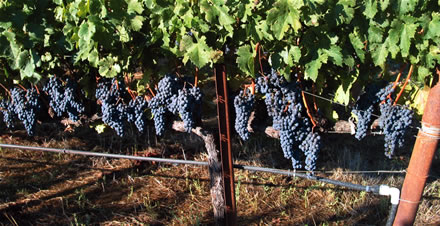
Fungicides for organic winegrowing
Preventative fungicide applications are the backbone of an effective powdery mildew control program since the disease is difficult to control and potentially very damaging if it becomes widespread in the vineyard. Most growers will apply early season treatments regardless of whether they have detected infections.
Micronized sulfur (in a product approved for use in organically certified vineyards, such as Kumulus 80 df) applied at full bud break is highly effective at stopping powdery mildew infections early in the season. The entire vine should be wetted. This application has been shown to reduce disease at its onset by 95%. The treatment is still equally effective, even if the ascospore release event does not occur until several weeks later.
It is necessary to re-treat the vineyard as shoots expand and new tissue grows. Growers usually re-treat the vines every 10-14 days pre-bloom. Most wineries want growers to stop using micronized and wettable sulfur materials just prior to bloom (and switch to sulfur dust for later applications) to ensure that reduced odors don't occur in wines made from treated fruit.
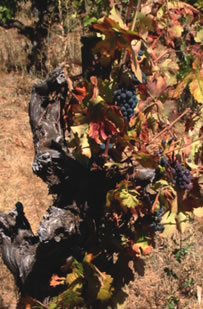
Sulfur dust is one of the most effective and inexpensive fungicides available to organic growers to control powdery mildew. Applications are made every 7-14 days, depending on disease pressure. Usually dust is applied to every other row, and it is a very easy and fast operation. There are multiple drawbacks, however:
- You can't apply sulfur dust effectively if it is windy (above 5 mph), so you need to dust when the air is still, a real problem in windy areas.
- Sulfur dust can easily drift into non-target areas, and this can be a problem near residences or crops susceptible to damage from sulfur dust (apples and pears).
- Sulfur dust is toxic to some important beneficial insects and mites, and it may encourage damaging spider mite populations.
- If temperatures rise above 100°F immediately following an application, fruit and foliage can be damaged.
- Sulfur dust is identified as a PM 10 pollutant, and its use may be restricted by various air quality control districts as part of a clean-air program.
- Sulfur dust is highly visible if you are making applications when the air is still. Many growers make their applications at night when the weather is cool, and there is less human activity in the area adjacent to the vineyards being treated.
- Sulfur dust can be irritating to vineyard workers if it gets on their skin, in their eyes or respiratory system. If possible, try to plan vineyard work activities four or five days after dusting to minimize contact between workers and sulfur dust.
Besides stylet oil, other possible fungicides that organic winegrowers can use include potassium bicarbonate (Kaligreen, Armicarb) and the biological fungicides Bacillus subtilis (Serenade) and Bacillus pumilus (Sonata). These materials are suitable for low- to moderate-pressure disease conditions and are used toward the end of the powdery mildew season when air temperatures are becoming higher, and mite activity is increasing (both conditions make using sulfur dust a less favorable choice). Other materials have been shown to work experimentally , but are not yet registered.
Dave Koball starts with stylet oil in the vineyards most prone to mildew attack. "We find that stylet oil is really the most effective fungicide early in the season for our Chardonnay vineyards along the Russian River. Those vines are vigorous and trained on a three-wire California sprawl system. On VSP systems, we can use micronized sulfur, which is cheaper but less effective in the high pressure areas," Koball explains.
"We find that if we start clean, we tend to stay clean. After bloom, we switch to dust, which works great as a preventative. In some problem spots, we have used stylet oil at 1% all season long with good results. The key to making those sprays effective is to have great coverage. We start at 50 gallons of water every row, then increase it to 75 gallons every row, and finally, when the canopy is fully expanded, we go to 100 gallons per row. We can stretch the intervals to 12 days apart, because stylet oil is a good eradicant if any mildew starts to grow."
Canopy management
When fruit set has occurred, removing leaves around the clusters is very beneficial, particularly if the vines are vigorous. Exposing the clusters early in the growing season by removing four to six basal leaves on every cane causes the cuticle of the fruit to thicken, which helps to resist mildew infections.
Exposed fruit also has a less humid microclimate, and sunlight is likely to hit the fruit for part of the day, discouraging mildew growth. Finally, when you do need to spray or dust, it is easier for fungicides to contact the fruit, improving disease control. Experience has shown that early leaf removal greatly aids powdery mildew control, and is really the only way to effectively control bunch rot caused by Botrytis cinerea.
The amount of leaves to remove depends somewhat on your climate, trellis system and variety. In cooler areas, with vigorous vines and California sprawl type trellising, heavy leaf removal is often useful to improve fruit quality and aid in disease prevention. In warmer areas with red winegrape varieties on vertical shoot positioned trellis systems (VSP), a lighter leaf removal approach might be more appropriate to avoid sunburn and poor coloring of the fruit. Leaves should probably be removed only on the side of the vine that receives morning sunlight.
Growers are also finding that removing only lateral stems (if they form) on red varieties grown on VSP trellises also reduces the conditions that favor disease, while still preventing the fruit from becoming sunburned.
Cleaning an infected vineyard
Occasionally, powdery mildew may infect a vineyard despite a grower's best efforts to prevent this from happening. Leaf pulling and spraying the fruit by hand with large amounts of water can stop infections and clean fruit. JMS stylet oil or potassium bicarbonate (Kaligreen, Armicarb) usually are applied to stop further infections. Badly damaged fruit should be dropped. Work with your winery customer closely to be sure that there are no "surprises" on the crush pad when you make a delivery.
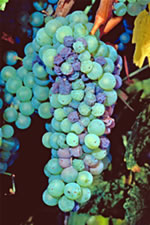
Botrytis shoot and bunch rot are caused by the fungus Botrytis cinerea. Ideal disease conditions occur when there is free moisture from rain or dew and temperatures are between 65° to 72°F. When it rains late in the spring and remains overcast for several days, shoot, leaf and flower infections can occur. You can recognize the disease by brown lesions that form on infected tissue, followed by fuzzy gray-brown sporulation. The fungus survives over winter by forming black colored dormant structures known as sclerotia on leftover fruit or other plant tissue. When conditions are right, the sclerotia germinate and produce gray-brown spores (conidia).
Botrytis disease may occur when flower tissue is infected. Often floral debris (such as leftover anthers, sepals and calyptra) can become nearly 100% infected, serving as inoculum for infections later in the season. Sometimes infections occur in the flower at bloom time that become dormant within the small berries until sugar content increases. If it rains late in the summer or fall and conditions are right, the fungus resumes growth and consumes the berry. It may also spread to the rest of the cluster.
High relative humidity is required for sporulation (around 90%). As the early infections sporulate, mature berries can become infected. The disease moves easily from an infected cluster to a healthy one if there is direct contact and free moisture on the surface of the fruit. Any physical damage to the fruit from birds, insects or even previous powdery mildew infections may serve as an entry point for Botrytis to infect the cluster. As sugar content of the fruit increases, it becomes more susceptible to infection.
Wineries will reject infected fruit because when fermented with sound fruit, it can produce off flavors, clouding and unstable color in red wines. Sorting and culling of damaged fruit should be done at the time of picking and again before the grapes are crushed by running the fruit across a sorting table, if necessary.
When extensive disease occurs in some white varieties such as Riesling, Pinot Gris or Gewürztraminer, growers and wineries may opt to harvest the fruit later, as Botrytis-infected fruit will often continue to accumulate sugar. If other secondary infections do not occur, the resulting wines are often highly flavored and sweet.
Disease control options
Cultural practices remain the best options for organic growers to control Botrytis:
- Canopy management including leaf removal around clusters, shoot positioning, sterile shoot removal and lateral shoot removal all improve air movement and lower humidity in the vine canopy microclimate. These practices create a less favorable environment for infections to happen.
- Thinning the crop so that grape clusters are not touching each other is recommended if favorab le disease conditions are likely to occur.
- During bloom time, run an air blast sprayer or other blower to remove debris from the flowers.
- For three-wire California sprawl-type trellis systems, cut canes just before harvest if wet weather is expected, to improve air circulation for lower humidity in the canopy microclimate.
Control programs should be based on cultural practices, as fungicides (even in conventional vineyards) are limited in their ability to prevent and stop Botrytis infections.
III. Phomopsis cane and leafspot
Phomopsis cane and leafspot caused by Phomopsis viticola is a fungal disease that occurs when spring weather is cool and wet, particularly after bud break. The disease is moved by splashing rain. The basal leaves of the vine often become distorted when infected and fail to develop to full size. Infected canes are usually stunted and poorly attached to the spurs. Infected buds often fail to open.
When the disease is widespread, flowers and young clusters can become infected and fail to grow. Stunted canes may fail to flower the next season, a problem if the vines are cane pruned. You can recognize the disease by small dark spots with yellowish margins on leaves in the spring following rain. The shoots often have black streaks and are usually stunted. The disease overwinters as small black fruiting bodies called pycnidia that grow on spurs, and fungal spores are splashed by rain onto emerging shoots, and become infected if conditions are right.
Control measures
If Phomopsis is a reoccurring problem in your vineyard, inspect the canes in the fall to see if they have a "bleached" look to them, which is indicative of infections from the previous growing season. Apply wettable sulfur at the highest rate right after bud break, before shoots have started to grow. Lime sulfur can also be applied as a dormant spray at relatively high rates if the disease has been a problem in the previous growing season, and wet weather is expected following bud break.
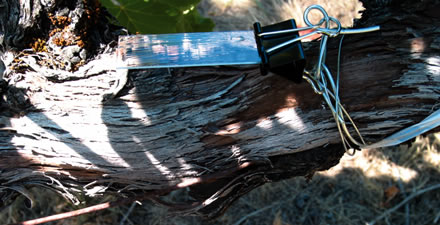
Eutypa & others
The long-term health of any vineyard depends on controlling wood-rotting diseases that are likely to infect the vineyard after age 12 or so, when the permanent structure of the vine is well formed and is not as actively growing as during the early years. Most wood-rotting organisms form fruiting bodies on the trunk and cordons and release spores in the winter and early spring. Some varieties are very susceptible to disease, including Sauvignon Blanc, Cabernet Sauvignon, Chenin Blanc and Petite Sirah. Infections take place during rainy weather in the winter and occur in pruning cuts. Spore releases tend to be at their peak in early winter when rainy weather is likely.
Eutypa die back is caused by Eutypa lata. Bot canker is caused by Botryosphaeria rhodina and up to eight other species. In the later stages the symptoms of both diseases are quite similar--dead spurs and cordons. When infected wood is cut, the cross section reveals wedge shaped discolored areas. Eutypa symptoms in its early stages include stunted, yellowish color, and tattered margins on the foliage. Often with Bot canker, there are dead sunken areas adjacent to the spurs. Both diseases may take years for symptoms to show, but Bot canker is believed to grow faster than Eutypa.
Control measures
Susceptible varieties can be a real challenge to grow if weather conditions favor disease development. Management is further complicated by the fact that for Eutypa, native plants such as willow, ceanothus and big leaf maple, and numerous cultivated crops including kiwi, cherry and apricot trees can also host this fungus. The following control strategies can be used:
- Prune susceptible varieties late. By far the mostly likely time for infections is in the early part of the winter.
- Minimize large pruning wounds. If you have to make large cuts on the vine, do it during the summer months.
- Consider cane pruning the vines, as there is less large permanent tissue to host the disease.
- Pre-prune the vines and leave long spurs that you can cut at around bud break to the desired number of buds.
- Lime sulfur applications applied when the vines are dormant may have some value in killing fruiting bodies in the trunk and cordons. Consider an application if your vineyard is having serious disease problems.
- Mark affected vines and prune out dead wood in the summer. Remove from the vineyard and burn, if possible.
- Retrain vines by removing diseased wood and start a new cordon with a healthy cane.
Organic winegrowers have a limited number of tools to combat grape vine diseases, yet for most problems, there are either effective fungicides or cultural practices that help them to keep their vineyards healthy. Continuing research will probably bring new tools that are useful to both organic and conventional growers.
Glenn T. McGourty is a winegrowing and plant science adviser with the University of California Cooperative Extension in Mendocin o County, Calif. He wishes to give special thanks to Dr. Doug Gubler and Jenny Broome of UC Cooperative Extension, who were invaluable in providing information used in this article. To comment on this article, e-mail edit@winesandvines.com.
|
|
PRINT » |
|
|
E-MAIL THIS ARTICLE » |
|
|
CLOSE THIS WINDOW » |
